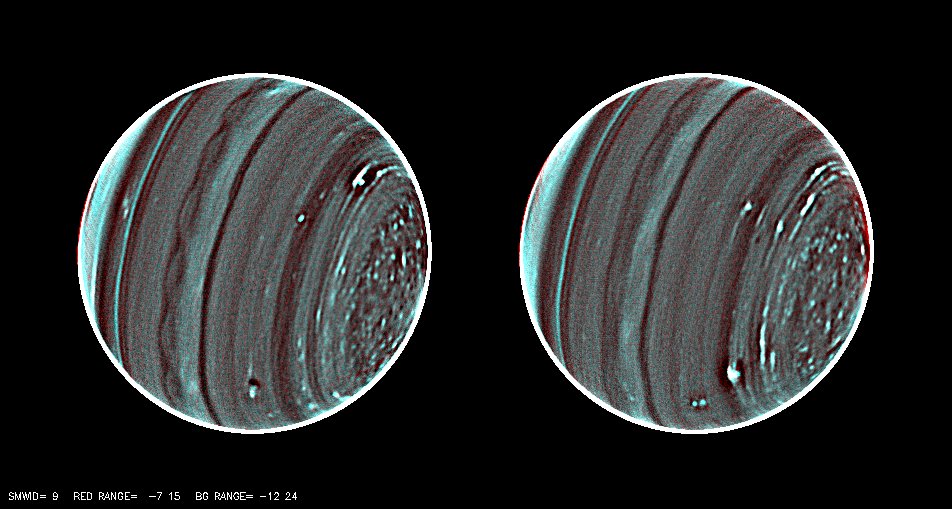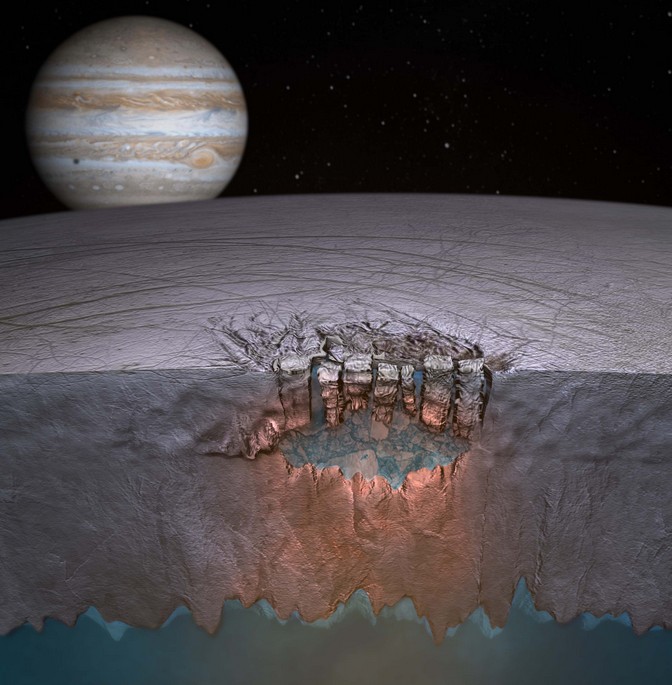Despite four decades of planetary explorers reaching across the solar system to Jupiter, we still don't have the answer to a very basic question - why is Jupiter's Great Red Spot.... red? And that's not the only conundrum - Jupiter's stripes, storms, vortices and waves can take on a bewildering range of colourful hues, from dusky white to yellows and ruddy browns, and even hints of green and blue tints if you look at the right moments. And yet the atmospheric chemistry responsible for the jovian rainbow has remained elusive. This post was inspired by interactions with the BBC research team for some of their upcoming science shows.
What are the clouds made of?
 |
The colourful clouds of Jupiter seen by Cassini
(Credit NASA/JPL/University of Arizona) |
When you look at Jupiter through a telescope, you're seeing photons of light being reflected back from the cloud tops in Jupiter's atmosphere, at pressure levels not dissimilar to the atmospheric pressure at the Earth's surface. These clouds reside in the atmospheric region known as the troposphere, the location of the swirling, churning weather activity we're all familiar with. Unlike on Earth, where water condenses and/or freezes to form the white clouds in our atmosphere, theory suggests that the ice clouds on the giant planets should be layered. Ammonia condenses to ammonia ice at the coldest temperatures, so form the uppermost cloud decks. That means that the bulk of the gaseous ammonia is locked away in a reservoir beneath the clouds. Above the clouds, there's only a little ammonia left to interact with UV light to form photochemical hazes.
Moving deeper into the planet, the ammonia can react with hydrogen sulphide to form a cloud of NH4SH, the next thick cloud deck. And even deeper, water condenses to form a thick aqueous cloud layer which may be the source of much of the convective activity that we see. It's important to note, however, that it's really hard to peer down through the topmost ammonia cloud, so all these deeper clouds are predictions based on chemistry. We don't know, for example, exactly how much water is locked away within Jupiter, but that determines the height and extent of any water cloud that would be there [that's one of the key goals of NASA's Juno spacecraft, two years away from arrival at Jupiter]. So our understanding of what's going on beneath the clouds you can see through a telescope is really limited, and largely constrained by theory rather than direct observation.
 |
| The cloud decks of Jupiter. |
Unfortunately, the picture is even murkier than that. Ammonia ice has a well-understood spectral fingerprint, with features that we could potentially identify in spectra of Jupiter's reflected light. Try as we might, we only ever see these signatures in small regions of the planet. Working with Galileo spacecraft observations in the near-infrared (NIMS), ammonia clouds were only detected in very localised regions associated with powerful convective dynamics covering less than 1% of the planet, almost like the ammonia ice could only be detected when it was fresh (i.e., newly transported up to the cloud decks from below). The most prominent signature was found in turbulent wake to the northwest of the Great Red Spot. Generally speaking, the Galileo observations (in tandem with ground-based studies) showed that these pure, fresh ammonia ice signatures were absent across much of the planet. In essence, although we suspect that we're seeing clouds of ammonia, we cannot confirm it using data from cutting-edge spacecraft.
In the past five years attention has focussed on anomalous spectral features near 3 microns, observed by both the Infrared Space Observatory (ISO) in the 1990s and the Cassini near-infrared instrument (VIMS) on its 2000/2001 flyby of Jupiter. This signature seems to be present everywhere, from light zones to dark belts, but the actual cloud composition responsible for the signature is unclear - maybe it is a combination of the ammonia and NH4SH clouds, with one species coating a seed of the other one, masking the signatures we'd expect. It certainly wasn't the signature of pure ammonia ice. Possible water ice signatures were even harder to identify, but were tentatively seen in Voyager data. To summarise - those top clouds certainly have nitrogen-based species in them, but how much, and how it's mixed/coated with other species, remains unclear.
But what about the colours?
The basic problem in all this is that ammonia ice is white (and water ice, for that matter). Nice, clean, white. So if that's not the source of the array of colours we see, there must be something else. Focussing specifically on the red colourants, we're looking for some cloud or haze that absorbs all the blue light from the Sun, and therefore only reflects back the red. The only thing we know for sure is that it has to be a blue-light absorber that's present in some places (reddish belts and giant vortices) but absent elsewhere (white belts and whitish small ovals). What might it be?
Here's the crux of the matter - there are lots of candidates that could fit this bill. The most likely explanation lies in the 'haze' above the main cloud decks. If we define clouds as those volatile gas species that condense, then the haze is the thinner, more ubiquitous aerosol particles that sits over the top of the main nitrogen-based clouds. Light being reflected from Jupiter's clouds is being filtered by that haze, so maybe the blue-light absorber is present there. There are lots of ideas, but observations don't help distinguish between things. Maybe material dredged upwards from the deeper troposphere by powerful convective updrafts then reddens in the presence of UV light, which might work for phosphorus (e.g., red triclinic phosphorus, P4) or sulphur based species. Or photochemical reactions of ammonia and phosphine could form hydrazine or diphosphene, respectively, whose spectral properties are poorly understood but could be key compounds in the hazes. Or some sort of poorly-understood ultraviolet tanning of aerosols that hang around for a long period of time. Maybe the products of methane-based photochemistry in the stratosphere could be raining down into the troposphere like a smog, coating the seed aerosols that are already there. In that case, we'd be seeing long-chain hydrocarbons, polymers, maybe an organic sludge known as tholins. It's really tough to rule any of these out with the data we have today.
So how do we solve the problem?
 |
Comparing cloud colours from Hubble with
atmospheric temperatures from VLT (Fletcher et al., 2010) |
Well, perhaps the only way to do this properly would be to have multiple Jupiter entry probes falling into regions of different colours and designed to sniff out the chemical and optical properties of the clouds and hazes. We've already done this once with the Galileo probe, but we suspect that this entered a region of unusual meteorology called a hotspot that dried out the atmosphere of all its clouds. The probe was often referred to as having entered the 'sahara desert' of Jupiter. Failing that, we must continue the search using laboratory work (i.e., synthesising suitable jovian clouds in the lab and seeing what influences their colours) and theory (i.e., developing an accurate model of jovian chemistry). Recent lab work has shown some promise -
Carlson et al. presented results at a 2012 conference showing how tropospheric ammonia and stratospheric acetylene might be mixed together, photolysed and react to form a yellow-orange film and potentially nitriles like hydrogen cyanide (HCN) as a by-product, giving us an indirect way of studying the colouration problem. Jupiter's episodic colour changes, such as the 2009-2012 global upheaval of the cloud structure or the recent reddening of a northern-hemisphere oval, provides a useful way of relating colour changes to alterations in environmental conditions (temperatures, humidity, opacity) that we hope will provide additional insights.
In summary, we still don't know why Jupiter's red spot is red. And for planetary scientists, that's a little embarrassing. But we have plenty of ideas to try, theories to test and discount. Ultimately a combination of lab work, theory and observations will help solve this mystery once and for all.











